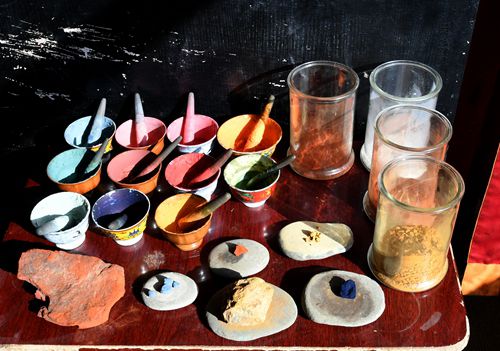


Annual Buddha tangka displaying ritual is held in Tashilhunpo Monastery in July 2019.
Young Tibetan people from poverty-stricken families in Southwest China's Sichuan Province can attend free Tangka art classes, allowing them to follow their dreams and change their lives.
There are three Tangka institutes or bases in Aba county of Aba Tibetan and Qiang Autonomous Prefecture, Sichuan. These institutes offer free courses for poor farming or herding families, the China News Service reported on Wednesday. More young Tibetan people, including those born after 2000, have picked up the art of Tangka painting at these institutes. Their participation in Tangka painting also provides new opportunities for the survival of this ancient art.
Tangka, a style of Tibetan art involving painting on embroidery, can be admired by tourists thanks to the thriving development of tourism in Tibet, where over 2,000 Tangka artists can create about 1,000 pieces of Tangka paintings every year, according to the Xinhua News Agency.
Tebuge, an inheritor of the Gula Pandita school of Tangka painting, published a textbook on Tangka. The book was reprinted for the eighth time in 2019, said the China News Service.
In April 2013, Tebuge founded a small Tangka teaching base and recruited 39 students. Tebuge taught them for free.
According to the report, the Tangka courses have three levels by complexity.
Zhaxi Lamu, a local-level culture and sport department official, said that painters in the base help students acquire painting skills for free. Most of the students go on to open their own studios or teach Tangka painting in other places. "This benefits not only local employment, but also preserves the traditional culture," he said, according to a report by the Sichuan News Website in 2017.

Students are working on Tangka.

A painter is drawing a Tangka featuring yaks on a stone.

The colors for painting Tangka

Sonam Drolma, a Tangka painting student born in 2000s, is at the Teguo Tangka base in Aba county of Aba Tibetan and Qiang Autonomous Prefecture, Southwest China’s Sichuan Province on January 13.

 Award-winning photos show poverty reduction achievements in NE China's Jilin province
Award-winning photos show poverty reduction achievements in NE China's Jilin province People dance to greet advent of New Year in Ameiqituo Town, Guizhou
People dance to greet advent of New Year in Ameiqituo Town, Guizhou Fire brigade in Shanghai holds group wedding
Fire brigade in Shanghai holds group wedding Tourists enjoy ice sculptures in Datan Town, north China
Tourists enjoy ice sculptures in Datan Town, north China Sunset scenery of Dayan Pagoda in Xi'an
Sunset scenery of Dayan Pagoda in Xi'an Tourists have fun at scenic spot in Nanlong Town, NW China
Tourists have fun at scenic spot in Nanlong Town, NW China Harbin attracts tourists by making best use of ice in winter
Harbin attracts tourists by making best use of ice in winter In pics: FIS Alpine Ski Women's World Cup Slalom
In pics: FIS Alpine Ski Women's World Cup Slalom Black-necked cranes rest at reservoir in Lhunzhub County, Lhasa
Black-necked cranes rest at reservoir in Lhunzhub County, Lhasa China's FAST telescope will be available to foreign scientists in April
China's FAST telescope will be available to foreign scientists in April